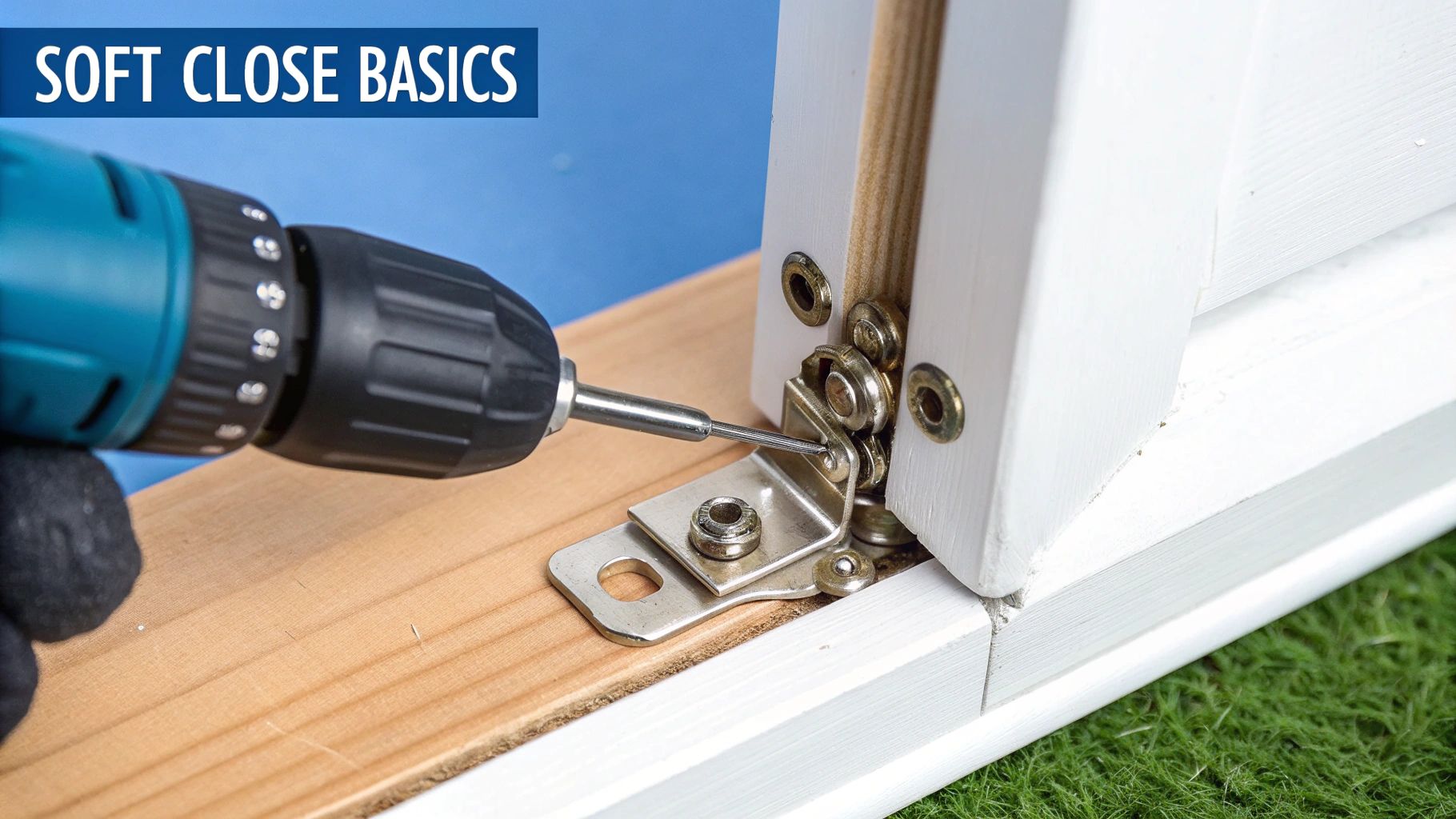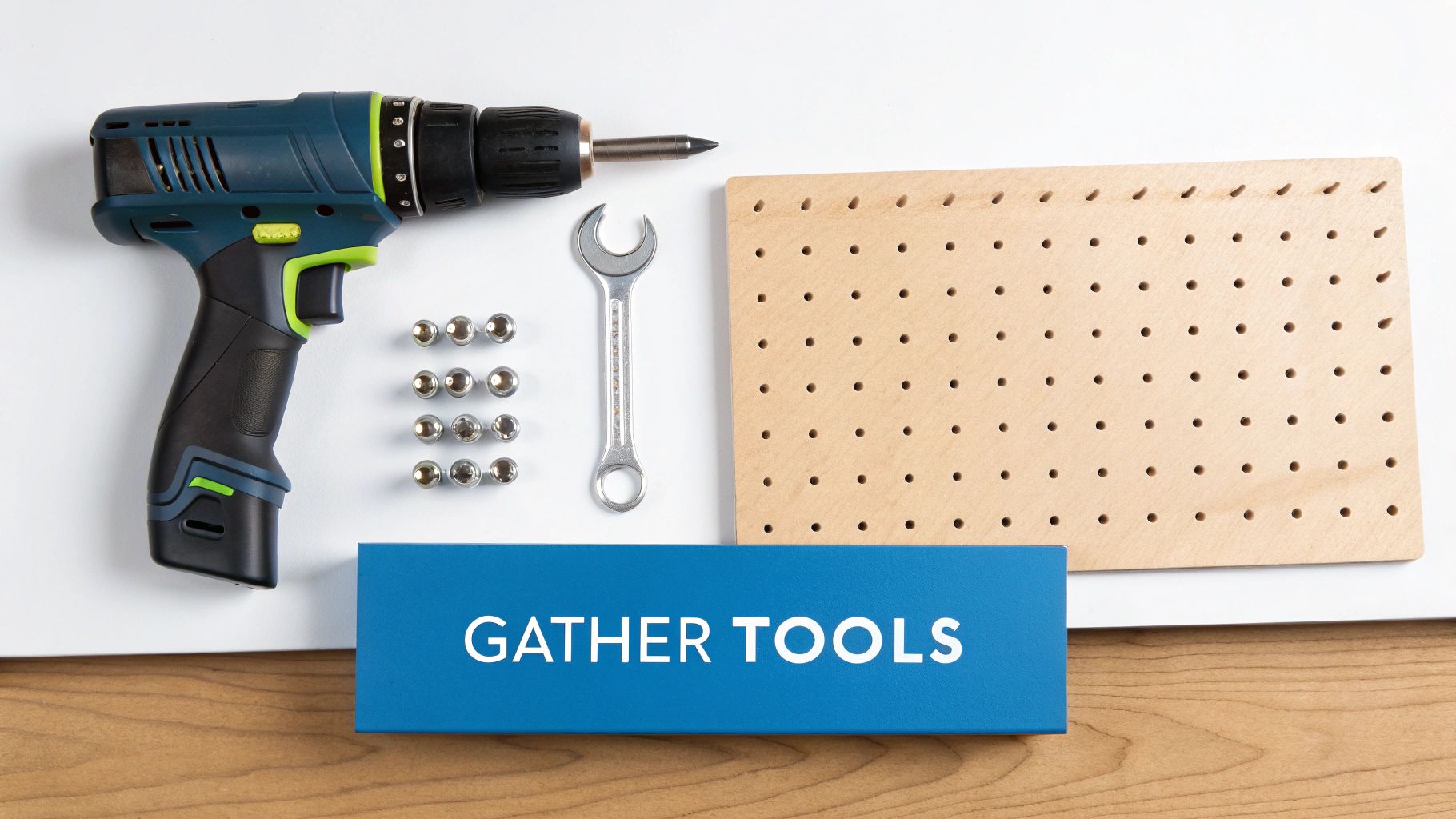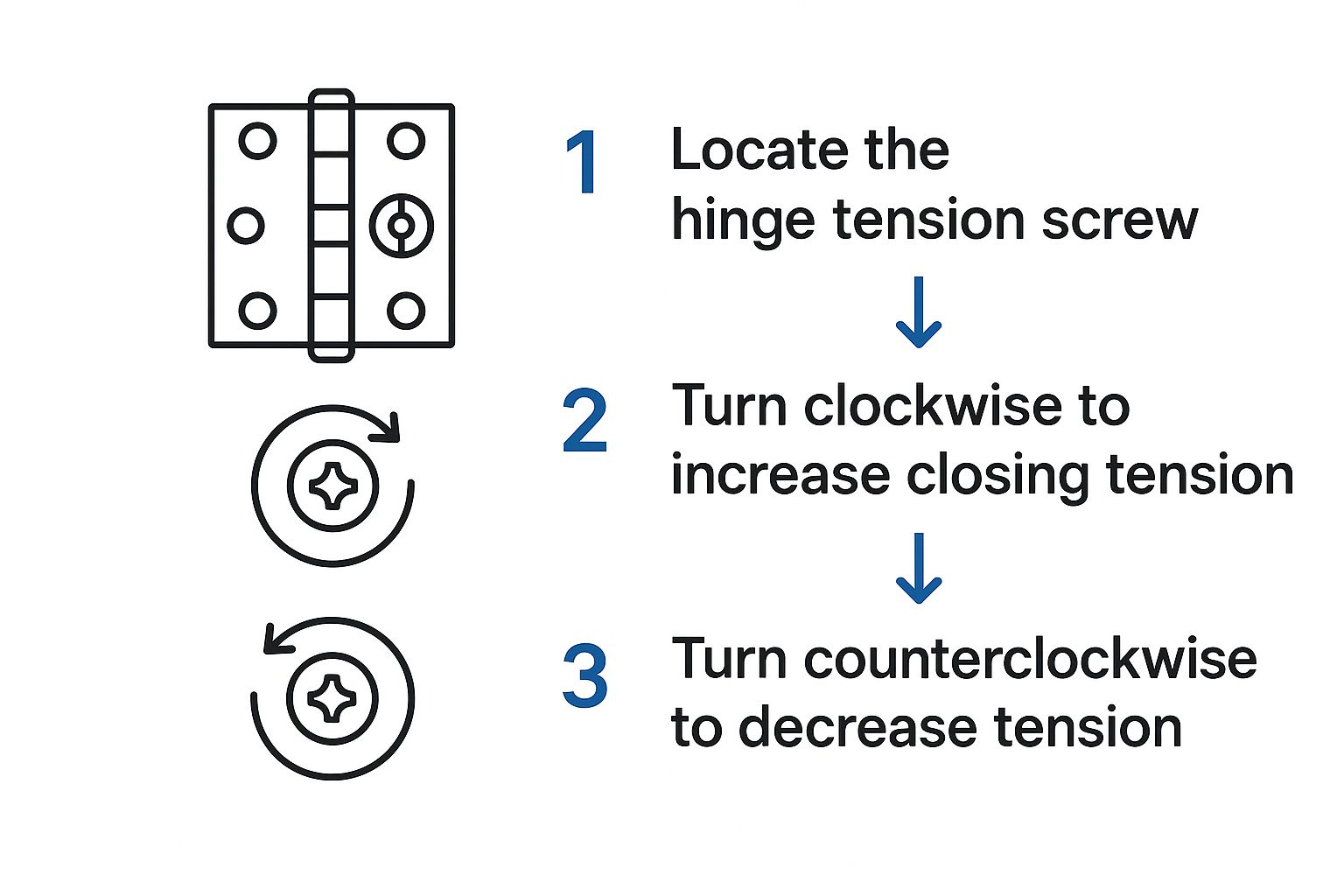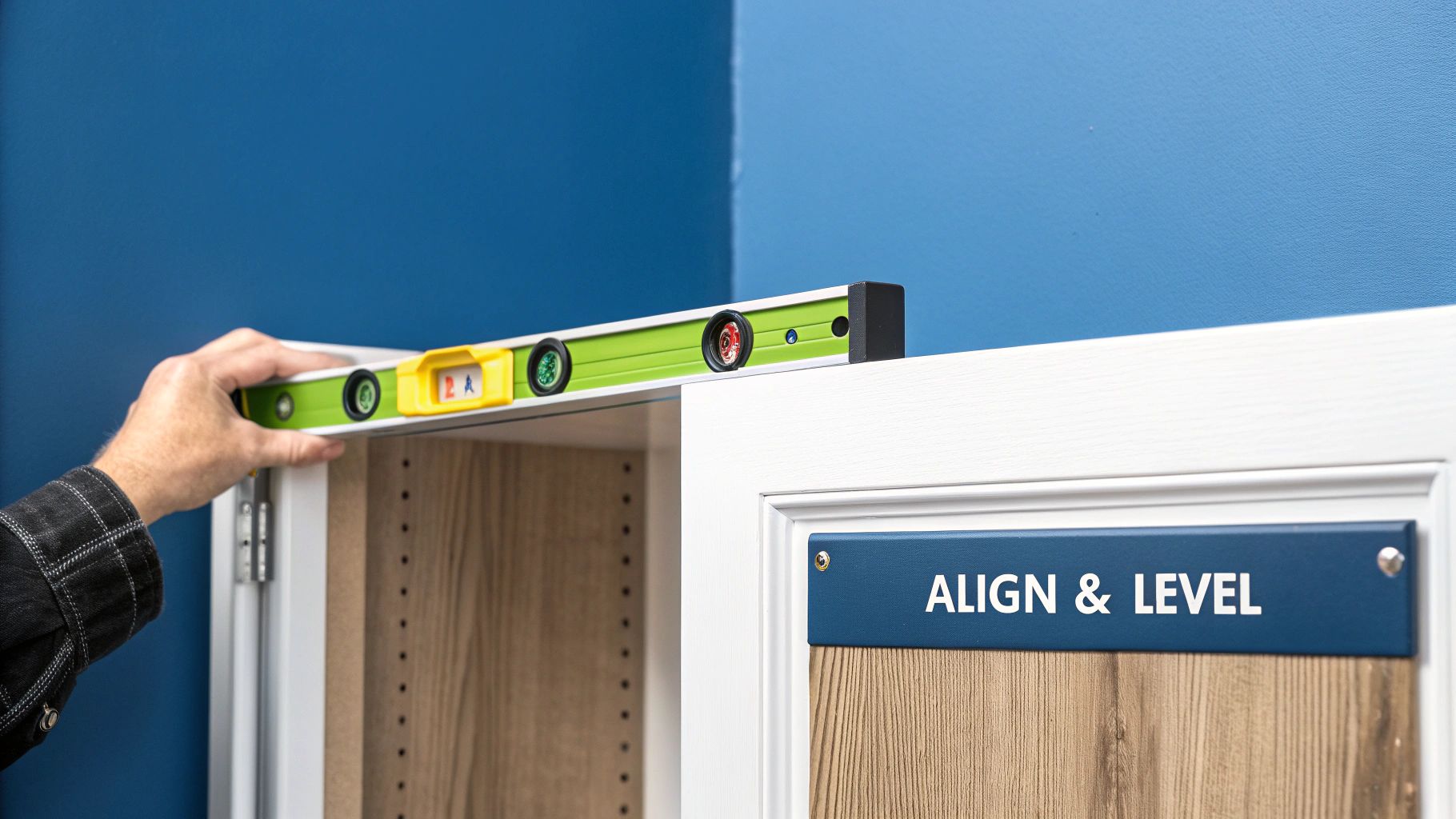- Straight to your door!
Straight to your door

That slamming cabinet door sound is something nobody wants to hear. Thankfully, fixing it is usually a straightforward job. All you typically need is a Phillips screwdriver to tweak the adjustment screws on the hinge.
It's all about making small, quarter-turn adjustments to the screws that control height, depth, and side-to-side alignment. A few careful turns are usually enough to bring back that smooth, silent close.

Before you reach for the screwdriver, it’s worth understanding just how vital these little mechanisms are in modern British homes. Perfectly adjusted soft close hinges aren't just a luxury; they're protecting your investment by preventing the daily wear and tear from slamming doors.
This simple feature preserves the finish and structural integrity of your cabinetry, which can make a huge difference to its lifespan.
The desire for a quieter, more peaceful home has turned soft close hinges from an optional extra into a standard expectation. Their popularity has really surged over the last decade.
Industry estimates suggest that soft-close hinges now make up approximately 35-40% of all cabinet hinges sold in the UK residential market. This growth isn't just about noise; it's driven by homeowners wanting to prevent damage and maintain the quality of their kitchen and furniture fittings. You can find more detail on this trend in reports on the UK lock and hinge manufacturing market.
A quick, simple tweak can restore that satisfyingly silent function, making a noticeable improvement to your daily life. It’s a small detail that contributes a lot to the feel of a well-maintained, premium home.
Key Takeaway: Correctly adjusted soft close hinges don't just stop noise. They actively protect your cabinet doors and frames from damage, helping them last longer and look better.
There are many different types of cabinet door hinges out there, but the adjustment principles for most modern soft close models are thankfully quite similar. Getting to grips with the basics now will save you a headache later on.

Before you dive in and start turning screws, a little prep work goes a long way. The great news is you won't need a specialist tool kit to get your cabinet doors looking perfect. In most cases, a simple Phillips head screwdriver is all you'll need – the same kind you probably already have stashed in a kitchen drawer.
The most important first step is to get familiar with the adjustment screws on your particular hinge. It’s tempting to just start twisting, but turning the wrong one can throw the alignment off even further, creating more work for yourself. Take a moment to see how they're laid out. While most modern hinges follow a similar three-screw pattern, knowing exactly what each one does is the key to a quick and painless adjustment.
If you're fitting these hinges from scratch, our guide on how to install concealed hinges is a great place to start for the basics.
Most soft close hinges have three main screws, and each one controls a different direction of movement. Once you know what they do, you'll be able to fix any alignment issue with confidence.
Here’s a quick rundown of what each screw is for:
To make things even clearer, here’s a quick-reference table that breaks down what each screw does. It can be handy to have this nearby when you’re making adjustments.
| Soft Close Hinge Adjustment Screw Guide |
| :--- | :--- | :--- |
| Screw Location | Adjustment Type | What It Fixes |
| Front Screw (closest to door edge) | In-and-Out (Depth) | Doors not sitting flush with the cabinet frame when closed. |
| Middle Screw (often slotted) | Up-and-Down (Vertical) | Doors scraping the bottom or not aligning vertically with other doors. |
| Rear Screw (closest to cabinet back) | Side-to-Side (Horizontal) | Uneven gaps between doors or doors hitting each other. |
With this guide, you can quickly identify which screw to turn to solve your specific alignment problem, saving you a lot of guesswork.
Expert Tip: Don't overlook the tension adjuster. It's often a small switch or a separate screw, sometimes hidden on the hinge cup itself. This little feature controls how fast or slow the door closes, letting you fine-tune that soft close action for a perfect, gentle finish every time.
Right, you’ve got a handle on which screw does what. Now for the satisfying bit: making the adjustments. The secret here is to go slowly and methodically. A tiny quarter-turn of a screw can make a much bigger difference than you'd expect.
My advice? Adjust, step back and check, then adjust again if you need to. It’s the best way to avoid overcorrecting and will get you that perfect, professional-looking finish much faster.
Is one door hanging slightly higher or lower than the one next to it? That’s a classic vertical alignment issue, but thankfully, it’s usually the easiest to sort out. It's often the culprit when a door scrapes along the bottom of the cabinet frame or just looks wonky next to its neighbour.
To fix this, you’ll be tweaking the screws that control the up-and-down movement. On most hinges, this means slightly loosening the two main screws on the mounting plate—the part that fixes the hinge to the cabinet frame itself. Once they’re loose, you can physically nudge the whole door up or down by a few millimetres. When you’ve got it sitting just right, simply tighten those screws back up securely. Job done.
Nothing throws off the look of a kitchen more than uneven gaps between the cabinet doors. The horizontal adjustment screw is your best friend for getting those lines perfectly straight and uniform. This screw shifts the door left and right, bringing it either closer to or further away from the adjacent door.
A common problem I see is a pair of doors with a V-shaped gap that’s wider at the top or bottom. You can straighten this out by adjusting the horizontal screw on the top hinge of one door and the bottom hinge of the other. Remember: turning the screw clockwise pulls the door towards the hinge, and anti-clockwise pushes it away. Patience and small turns are the key here.
Pro Tip: When you’re adjusting a pair of doors, try to adjust both of them a little bit, rather than moving one door a lot. This helps keep the overall alignment balanced and gives a much cleaner result.
The final piece of the puzzle is the depth adjustment. This determines how far the door sits from the cabinet frame when it's closed. If your door sticks out proudly from the frame or sinks too far in, this is the screw you need to turn. A perfectly flush door not only looks infinitely better but also ensures any soft-close mechanism can engage properly.
Getting this right is crucial for that sleek, modern finish. It’s one of the key reasons why concealed hinges are the secret to sleek cabinetry.
This image shows a simplified look at adjusting the tension, which is another important part of fine-tuning the soft-close action.

As you can see, a simple tweak of the tension screw lets you customise the closing speed to suit different door weights, preventing them from slamming or closing too slowly.

Once your doors are hanging perfectly, the last job is to dial in that soft close action. This is all about controlling the closing speed so your doors don’t slam shut or, just as annoying, drift closed at a snail's pace. You're aiming for that sweet spot: a smooth, controlled motion that ends with a quiet, satisfying click.
The weight of your door is the biggest factor here. A small, lightweight door needs very little resistance from the mechanism. On the other hand, a chunky, solid oak pantry door will need much more tension to slow it down properly. Nailing this balance is what gives your cabinetry that premium, high-quality feel.
How you adjust the closing speed can vary a bit between hinge brands. Generally, you'll be looking for one of two common mechanisms on the hinge itself.
Expert Tip: To get the best performance and avoid putting unnecessary stress on the hinge, professional fitters in the UK aim for a closing time of 1-3 seconds from a 90-degree angle. This gives a reliable close without causing long-term wear on the mechanism.
Always make small, gradual adjustments. Give the screw a slight turn or flick the switch, then open and close the door a couple of times to see how it feels. Keep tweaking it until you get that perfect, silent closure.
Even with the best planning, sometimes a cabinet door just won't cooperate. You might have one that refuses to close that last centimetre, makes an annoying clicking sound, or has a soft-close feature that's seemingly given up. Don’t panic – most of these headaches have a surprisingly simple fix.
More often than not, the problem isn't a faulty hinge but a minor adjustment that’s gone slightly askew. An overtightened screw, for example, can cause the mechanism to bind, while a loose one can make the whole door feel wobbly and insecure. Figuring out the root cause is half the battle.
Before you grab a screwdriver and start turning screws at random, take a moment to pinpoint the exact problem. This will save you a lot of time and frustration.
It's no surprise that improper adjustment is a common problem. In fact, data from UK cabinet installers shows that faulty soft-close hinge adjustment is responsible for nearly 60% of all post-installation service calls. You can read more about the findings in this report on common cabinet installation issues.
Quick Fix for Sticking Doors: If a door suddenly starts sticking when it was fine before, the depth adjustment screw is your first port of call. A small anti-clockwise turn can push the door away from the frame just enough to solve the problem without messing up the overall alignment.
To round things off, let's tackle a couple of the common questions that pop up when you're getting to grips with soft close hinges. These quick tips should help you wrap up your project feeling like a pro.
Absolutely, and in most cases, it's a pretty straightforward job. The cleanest way to do it is to swap out your old hinges entirely for new soft close models. You’ll just need to make sure the new ones are compatible with your cabinet style (framed or frameless).
If you're looking for a quicker, more budget-friendly fix, you can add separate soft close dampers to your cabinet frame. These little pistons work with your existing hinges to catch the door and ease it shut, giving you that smooth, quiet close without a full hinge replacement.
It happens. Usually, it's one of a few common culprits. The internal hydraulic damper could have failed, or it might just be clogged up with dust and grime.
First things first, have a look for a small switch on the hinge body itself. Sometimes these get knocked accidentally, which deactivates the soft close feature. If the switch is on and the hinge is clean but still not working, the damper has likely worn out. In that case, the hinge will need replacing.
A Quick Heads-Up: While most modern hinges use a similar three-screw system for getting the door aligned (height, depth, and side-to-side), the way you adjust the soft close tension can really vary between brands. If you're struggling, check the hinge for a brand name and do a quick search for a diagram online. It can save you a lot of guesswork.
For all your hardware needs, from the latest soft close hinges to essential fittings, explore the extensive range at Neasden Hardware. Find everything you need for your next DIY project at https://neasdenhardware.co.uk.